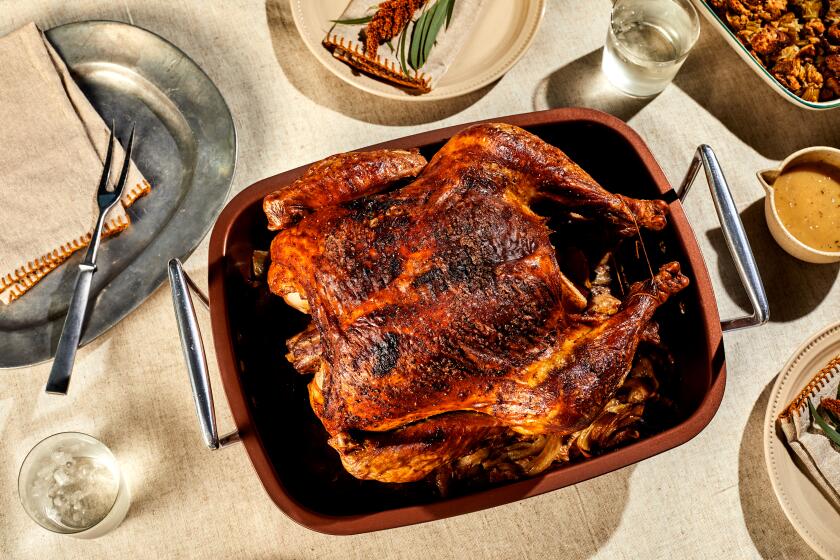Perfect Thanksgiving roast turkey

The perfect Thanksgiving turkey is one that is simple to prepare, prepped the day before you need it, and tastes great with no basting. This method stuffs seasoned butter under the skin so it bastes the turkey meat while it roasts (this also helps get salt into the meat to effectively “brine” it from the inside). At the same time, it crisps up the skin on top beautifully. This method works no matter the size of your turkey; just reduce or increase the roasting time accordingly. And if you want to add extra flavor to the seasoned butter under the skin, stir in 2 tablespoons lemon or orange zest (or both), minced rosemary or thyme, or 2 teaspoons crushed red chile flakes for a spicy kick.
This recipe is part of our Guide to Classic Thanksgiving, a collection of simple recipes for timeless holiday dishes to make this year and for years to come.
The day before, prepare the turkey: Pull out the neck and any gizzards from inside the turkey and reserve them for making gravy, if you like. Trim off any extraneous bit of skin or fat from the turkey and reserve or discard. Dry the turkey thoroughly, inside and out, with paper towels. Don’t try to remove the wishbone now but rather, wait until after it is finished cooking. Season the inside of the turkey thoroughly with some salt and pepper.
Using the tips of your index and middle fingers or the rounded tip of a small silicone spatula, slide under the skin of the breast, entering at the neck and on either side of the breast bone. As you do this, you will feel a thin clear membrane break, which will separate the skin from the meat. Tear through that membrane, not the skin, all over both sides of the breast of the turkey.
In a small bowl, use a spoon to stir together the softened butter, 1 tablespoon salt and the pepper. Lift up each opening you made over the turkey breasts and insert the spoon with some of the butter inside, using the skin itself to rake the butter off the spoon and onto the meat; repeat until most of the butter is underneath the skin over every entry point on the breasts. Using your hands, massage the butter through the skin, creating an even covering over the meat.
You will have about a sixth of the butter left over on your fingers and in the bowl, so scrape it onto the outside of the turkey and rub it evenly over every part, especially the drumsticks, thighs and wings, where there is no butter under the skin. Season the outside of the whole turkey with 1 to 2 tablespoons additional salt, depending on the size of your turkey; you want an even, liberal coating. Season with an even coating of more pepper as well. Place the turkey, breast side up, on a roasting pan’s rack insert and set it in a roasting pan or on a rimmed baking sheet. Refrigerate for 24 hours or overnight (this helps the skin air-dry and become crisp when you bake it).
The next day: Remove the turkey from the refrigerator 1½ hours before you plan to cook it; this gives it time to come to room temperature, ensuring it cooks evenly. Then, heat the oven to 350 degrees. While the oven heats, quarter the lemons and place them inside the turkey’s cavity. Tie the ends of the drumsticks together with kitchen twine, if you like. Scatter the onions under the turkey in the roasting pan, or if using a baking sheet, corral all the onions directly under the roasting rack so they’re completely underneath the turkey to catch its drippings.
Transfer the turkey to the oven and bake, rotating the pan halfway through cooking, until an instant-read thermometer inserted into the thickest part of each thigh reads at least 160 degrees, which will be around 10 to 13 minutes per pound, or 2½ to 3½ hours, depending on the size of the turkey.
Remove the turkey from the oven and tent it loosely with foil to keep it warm (the temperature will also continue to rise up to 10 degrees more while it sits). Let the turkey rest for at least 1 hour (it will still be quite hot) before carving.
When ready to carve, remove the foil and transfer the turkey to a large cutting board — preferably one with channels along the edges to help catch any juices — and carve. Scrape the onions out of the roasting pan or baking sheet and spread them over the bottom of a large serving platter. Place the carved turkey pieces over the onions and pour any juices from the pan and/or cutting board over the meat. Serve while hot, garnished with more lemon slices, if you like.
Eat your way across L.A.
Get our weekly Tasting Notes newsletter for reviews, news and more.
You may occasionally receive promotional content from the Los Angeles Times.











